Many artists have depicted the Christmas story from the the New Testament. From 313 CE (Edict of Milan) when Constantine declared the Roman Empire to be Christian, other sources influenced these stories. Many of these sources, some as old as the New Testament, were excluded from the official texts in the Bible for various reasons, although many are included in the Catholic Bible. Other books were written during the early Christian and Middle Ages to amplify the significance of Christ’s birth. The Infancy Gospel of Thomas (2nd Century, Rome), Protoevangelium of James (2nd Century Rome), Gold Legend (1275), St Bridget Vision of the Nativity (1372),(Sweden), and the works of the Venerable Bede (673-735), and others were major sources for artists when depicting the stories surrounding the birth of Christ. These stories were used in both Roman Catholic and Eastern Orthodox art.

“Journey to Bethlehem” (1320)
Caesar Augustus decreed a tax on all Roman citizens of one silver penny as a token of submission to Rome and as a census. In the mosaic “Journey to Bethlehem “(1320) (Chora Church, Istanbul), Joseph and Mary travel to Bethlehem to pay their tax. Mary rides on a donkey, made clear by it’s long ears, and Joseph walks behind. Both wear golden halos. Joseph is shown as an old man as he was a widower with several children. At fourteen Mary left her service in the Temple and of marriageable age was betrothed to Joseph. This Byzantine mosaic is typical in the Eastern Orthodox Church where all stories take place in heaven; the gold background represents the golden light of heaven and of God. On the journey to Bethlehem, the Infancy of Christ Gospel of Thomas recalls that on their way Mary and Joseph saw groups of people rejoicing and others lamenting. Mary asked the angel, who was guarding them, who these people were? The angel replies, “Those who rejoice are the people of the heathen who in Abraham’s seed are about to be admitted to eternal bliss. Those who grieve are the people of the Jews, for God is about the cast them out in accordance with their deserts.”

“Nativity” (Lorenzo Monaco) (1414)
Lorenzo Monaco’s “Nativity” (1414) (12.5 x 20.8’’) depicts Mary and Joseph with their new born son and the ox and ass in a stable/cave. The Protoevangelium of James, a Coptic text translated from Greek (2nd Century), reveals Joseph found a cave for them because there was no room for them in the inns. In the Holy Lands there were many caves, and these were used for stables. In the early Italian Renaissance, artists frequently combined the two structures; a stable roof, familiar to Italians, is built over a cave. On either side of the stable roof are blue and robed angels radiating golden streams of light and praising God. According to St Bridget’s vision (1372), Christ is not wrapped in swaddling clothes but is laid on the ground nude, and his radiance keeps him warm. Mary wears, what becomes a tradition, a rich blue robe with gold edging. Joseph’s robe is likewise edged in gold. These rich garments, not typical for a carpenter and his wife, were a part of the popular International Gothic style of art, in which gold was liberally applied to Holy figures dressed in rich garments. The elaborate gold frame, also International Gothic, was in the favored Gothic quatrefoil design. Unlike many paintings of this time, Joseph’s hand is raised in blessing. More frequently, artists did not know what to do with Joseph and often showed him sleeping. In other paintings Joseph is shown cutting up his socks to make swaddling clothes, getting water, cooking supper, or applying his trade as a carpenter fixing up the stable. Symbolically the ruined stable, sometimes consisting of a crumbling Roman column, represented the old law of the Jews, while any newly built repairs represented the new law of Jesus.
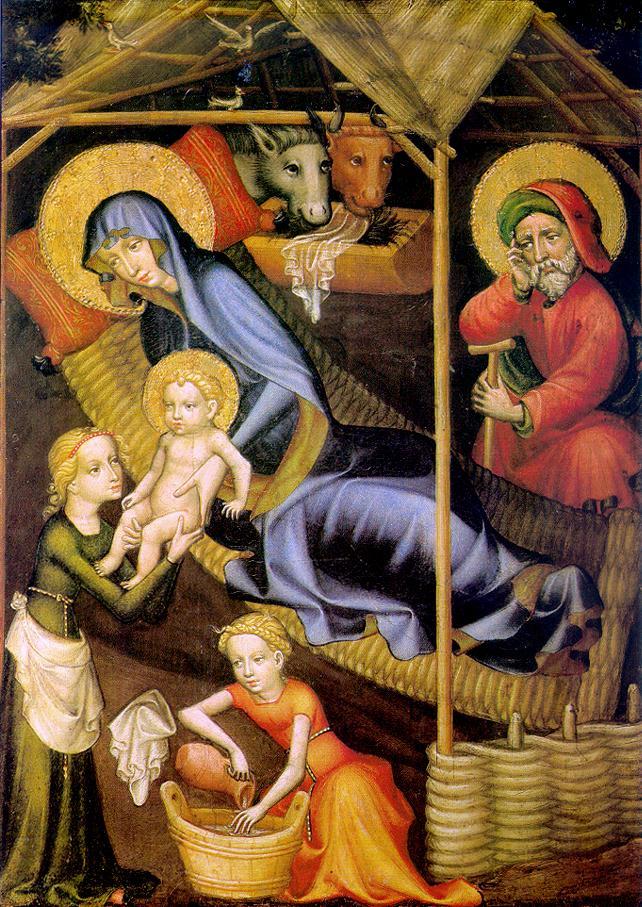
“First Bath”
Several versions of the Nativity story mention that two midwives assisted Mary with the birth and the bathing the Christ child. Pseudo Bonaventura (1300), recalls that Mary gave birth standing against a pillar in the stable, a precursor to Christ’s flagellation. The inspiration for many paintings of the Nativity came from St Bridget of Sweden (1372). She described her mystic vision of the Nativity: “And while she was standing thus in prayer, I saw the child in her womb move and suddenly in a moment she gave birth to her son, from whom radiated such an ineffable light and splendor, that the sun was not comparable to it, nor did the candle that St. Joseph had put there, give any light at all, the divine light totally annihilating the material light of the candle…. I saw the glorious infant lying on the ground naked and shining. His body was pure from any kind of soil and impurity. Then I heard also the singing of the angels, which was of miraculous sweetness and great beauty.”
The Protoevangelium tells of an unexpected encounter between Joseph and Salome. He was seeking for a midwife for Mary and she for a new mother. A spectacular vision appeared to her when she arrived at the stable and she immediately believed in the miracle of the child. Salome had a withered hand and at that moment an angel appeared to her and told her to pick up the child; her hand was whole and she exclaimed: “I will do him worship, for a great king is born unto Israel.” The Salome and the other midwife, whose name varies in different texts, proceed to bath the Child. Ritual baths plays play a major role in Jewish history. Water was scarce and therefore bathing was a significant event used for purification from many types of impure things. Three white turtle doves are perched on the ceiling beams. White doves are iconic symbols of the Holy Spirit and always symbolized purity. Three of anything also references the Holy Trinity, which has now been made complete.
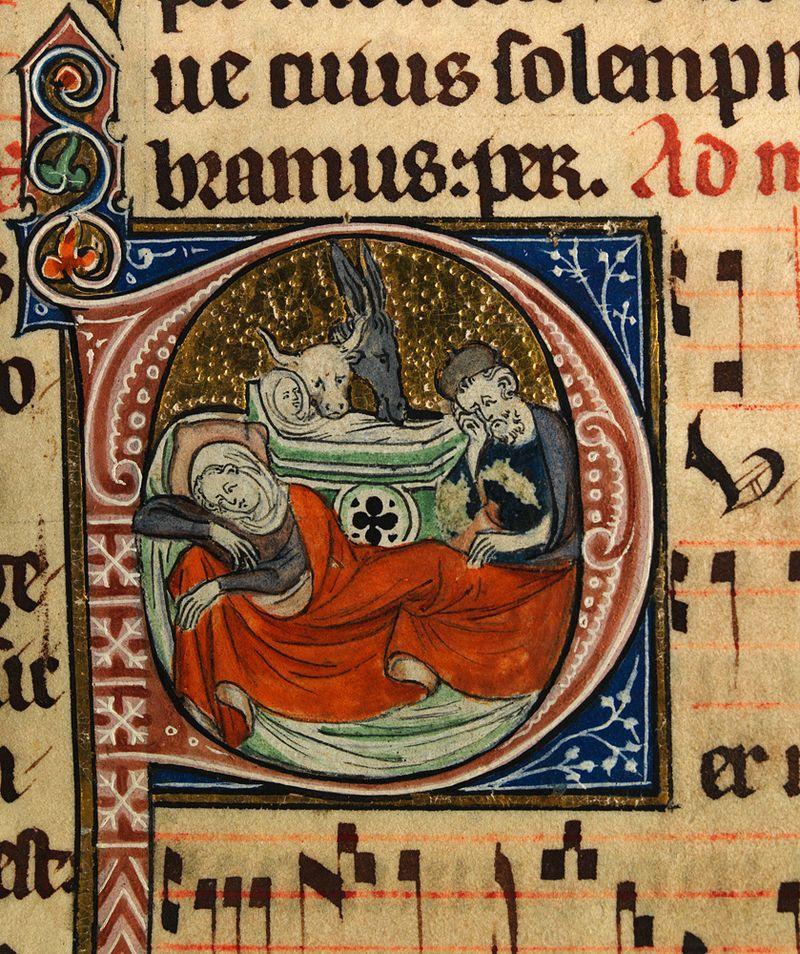
“Nativity” (1310-20)
The “Nativity” (1310-20) (English Missal) and the “First Bath” depict another aspect of the Nativity story. The ox and the ass appear as gentle and smiling creatures in the “First Bath.”The ox holds the swaddling cloth while the child is bathed. The ox and ass help to keep the child warm as they breathe on him. They watch over the child and straighten the swaddling clothes. The ox and ass are not mentioned as being present in the New Testament, but they are almost always included in Nativity scenes. The Infancy Gospel of Matthew (800), states that Mary left the cave on the third day and went into the stable, placing the child in a manger: “And an ox and an ass bent their knees and worshipped him. Therefore, the animals, the ox and ass, with him in their midst incessantly adored him. Then was fulfilled that which was said by Habakkuk the prophet, saying ‘Between two animals you made manifest’.” More significant was Isaiah 1: 3: “The ox knows its owner, and the donkey its master’s crib, but Israel does not know, my people do not understand.” The ox is symbolic of Israel and considered a clean animal. The ass represents the Gentiles and considered unclean. In the stable the Jewish and the Gentile world have come together. However, the Jews do not recognize Jesus. The ass is a mindless beast of burden, but is the animal of choice when Jesus rides into Jerusalem. The first Nativity crèche to include an ox and ass was created by St Francis of Assisi, who wanted to see and feel the reality of the manger.

“Annunciation to the Shepherds” (1405-08)
According the Bible, shepherds were nearby tending their flocks when angels appeared in heaven praising God and saying, “Gloria in ex Celsius Deo.” The “Annunciation to the Shepherds” (1405-08) (Book of Hours of Marshal of Boucicaut) is an elaborate International French Gothic scene with the city of Bethlehem, depicted as a French country village. Included in the scene is an attentive sheep dog, three shepherds, a flock of sheep, and a pond with a goose and white swan. The white swan was a symbol of feminine beauty and virginity, light, and innocence among other meanings. Sheep were significant to the Jews as their major source of sustenance, and for Christians, sheep were a symbol for God’s people.
The shepherds are depicted as common people and clothed in plain garments. In the Old Testament, Jews were frequently visited by angel messengers and so were not afraid to hear and see them. The scene is populated with elaborate flowering trees that served two purposes: they add to the International Gothic elegance and whether the artist knew it or not, December in the Holy Lands would probably be warm enough to support the flowers. Biblical sources often mention flowers blooming on the night of the Nativity.
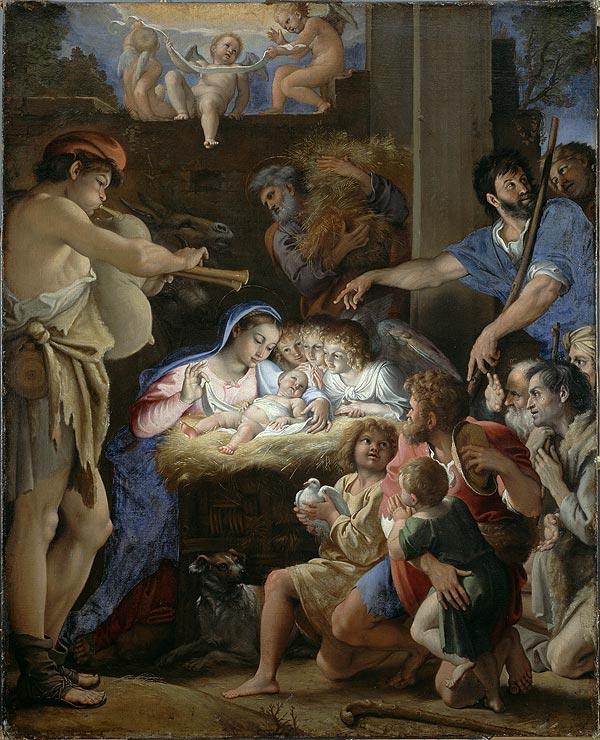
“Adoration of the Shepherds” (1670)
“Adoration of the Shepherds” (1670) (Domenichino), from the Baroque period, depicts joyful and adoring shepherds worshipping the Child. It was typical to see both male and female shepherds with their children bringing gifts to manger. A young boy holds two turtle doves to give as gifts, and a shepherd piper plays for the Child. Gifts of food included eggs, bread and fruit are often presented at the manger. Two different ranks of angels are shown, one group of three cherubs look down from above, and another group of three angels kneel adoringly at the manger. In the background, Joseph is feeding wheat to the ox and ass. The birth of Jesus takes place in the city of Bethlehem which means ‘house of wheat.’ Wheat was thought to ease the pains of child birth and was often available for births. St Helena, mother of the Roman Emperor Constantine who recognized Christianity, was said to have found the straw from the manger three hundred years later because the animals recognized its significance and did not eat it.
With the addition of the shepherds to the manger scene, The Golden Legend (1275) states that at Christ’s birth, “it was revealed to every class of creature, from the stones, which are at the bottom of the scale d creation, to the angels, who are at the summit.” Inanimate things with existence reacted to the birth when “the darkness of night was changed to the brightness of day…the water of a spring changed to oil. The Nativity was revealed to the creatures which possessed existence and life, such as the plants and trees. For in the night of the Savior’s birth, the vines of Engedi bloomed, bore fruit, and produced their wine. The Nativity was revealed to the creatures possessed of existence, life, and sensation, that is, to the animals. The ox and ass, miraculously recognizing the Lord, knelt before Him and adored Him. The Nativity was revealed to the creatures possessed of existence, life, sensation, and reason, that is, to men [the shepherds]. Finally, the Nativity was revealed to the creatures who possessed existence, life, sensation, reason, and knowledge, namely to the angels; for it was the angels themselves, as we have just seen, who announced the birth of Christ to the shepherds.”
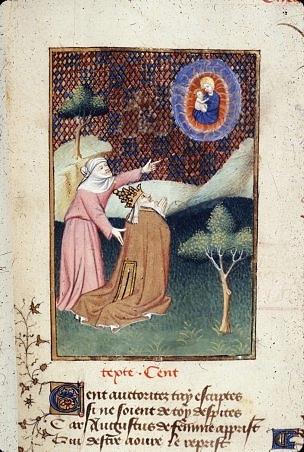
“Ara Coeli” (1410-14)
On the day of the Nativity of Christ’s birth The Golden Legend (1275) records Pope Innocent III (Pope 1198-1216) story of the “Ara Coeli” (1410-14) (Christine de Pisan Epistle Otheo). At this time the Roman Senate voted to declare Octavian (Caesar Augustus) a god. Caesar consulted with the Tibertine Sibyl and asked if this was his time to except divinity. Caesar and the Sibyl were alone, and “she saw a golden ring appear around the sun. In the middle of the circle stood a Virgin, of wondrous beauty, holding a child upon her bosom. A voice was heard which said: ‘This woman is the Altar of Heaven’ (Ara Coeli). And the Sibyl said to him: “This child will be greater than thou.” Another version of the event records the Sibyl as saying: “From the sky will come a king who will reign in human form for centuries and judge the world. This child is greater than you; also adore it.” All versions agree, Augustus immediately knelt down and worshipped the Child. This vision was said to appear on the highest hill, the Campidoglio, next to the Roman Forum and Senate. On that spot, Augustus built an altar to the “Lord of Heaven.” The church of St Mary in Ara Coeli now stands in that spot. As a result of this miraculous vision, Octavian declined divinity. He did accept divinity later and became Augustus.
Beverly Hall Smith was a professor of art history for 40 years. Since retiring with her husband Kurt to Chestertown six years ago, she has taught art history classes at WC-ALL and Chesapeake College’s Institute for Adult Learning. She is also an artist whose work is sometimes in exhibitions at Chestertown RiverArts and she paints sets for the Garfield Center for the Arts.
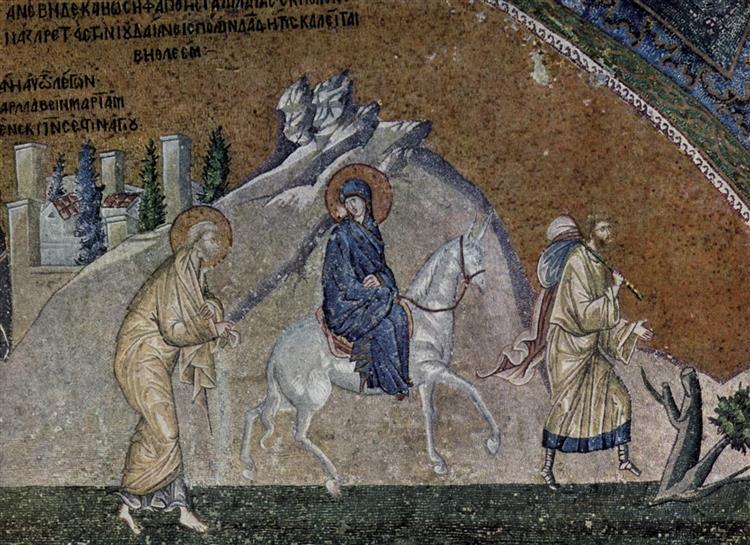


Write a Letter to the Editor on this Article
We encourage readers to offer their point of view on this article by submitting the following form. Editing is sometimes necessary and is done at the discretion of the editorial staff.